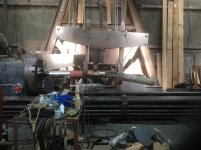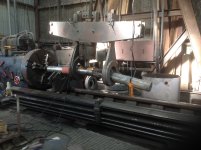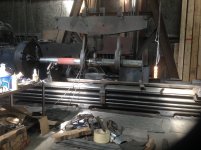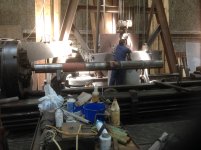jackie schmidt
New member
I have mentioned that one of the services we offer is straightenning things that get bent under Boats. This could be either the Prop Shaft or a Rudder.
One of our customers docked a 3000 HP Push Boat yesterday that had a bent Rudder. The Shipyard cut the blade off, and sent the Rudder Stock over for us to straighten. Here are some pictures of the Stock, and the Straightenning Rig we use.
As you can see, all of ththe tonnage is maintained in the Straightenning Rig and the Stock. The arms are adjustable so we can put "precision tonnage" at any point on the piece. No force is exerted on the Lathe what so ever.
We designed and built this rig. This one is 500 tons. We have a 150 ton, a 300 ton, and a 750 ton. You can see it in it's storage stand behind the big Lathe.
The whole operation took 2 men around 3 hours.
http://benchrest.com/attachment.php?attachmentid=19274&stc=1&d=1490983063
http://benchrest.com/attachment.php?attachmentid=19275&stc=1&d=1490983164
http://benchrest.com/attachment.php?attachmentid=19276&stc=1&d=1490983220
One of our customers docked a 3000 HP Push Boat yesterday that had a bent Rudder. The Shipyard cut the blade off, and sent the Rudder Stock over for us to straighten. Here are some pictures of the Stock, and the Straightenning Rig we use.
As you can see, all of ththe tonnage is maintained in the Straightenning Rig and the Stock. The arms are adjustable so we can put "precision tonnage" at any point on the piece. No force is exerted on the Lathe what so ever.
We designed and built this rig. This one is 500 tons. We have a 150 ton, a 300 ton, and a 750 ton. You can see it in it's storage stand behind the big Lathe.
The whole operation took 2 men around 3 hours.
http://benchrest.com/attachment.php?attachmentid=19274&stc=1&d=1490983063
http://benchrest.com/attachment.php?attachmentid=19275&stc=1&d=1490983164
http://benchrest.com/attachment.php?attachmentid=19276&stc=1&d=1490983220
Attachments
Last edited:






